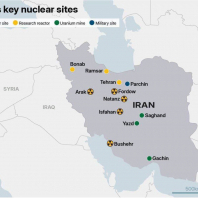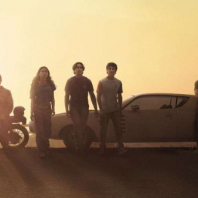Анонс Osprey на август 2023
 birserg_1977 — 01.04.2023
birserg_1977 — 01.04.2023

'The definitive account of the Vulcan raids... taught me
something new on every page'
- Rowland White, author of the bestselling Vulcan 607
A newly researched, fully illustrated account of how RAF Vulcan
bombers flew a series of the world's longest air raids in 1982
against Port Stanley airfield, in a daring, hastily improvised
strike against the Argentinian invaders.
The RAF's opening shots of the Falklands War were among the most
remarkable airstrikes in history. The idea was simple: to destroy
the runway at Port Stanley, and prevent Argentinian fast jets using
it against the Royal Navy task force. But the nearest British-owned
airfield was Ascension Island - 3,900 miles away from the
Falklands.
Researcher and historian Andrew D. Bird has uncovered new detail of
what really made these extraordinary raids possible, including
never-before-published information and photos demonstrating the
discreet support provided by the United States. Packed with
spectacular original artwork and rare photos, this book explains
how these hugely complex, yet completely improvised raids were
launched.
This is also the story of how the last of the Vulcans, only a few
months away from the scrapyard, had to be hastily re-equipped to
carry conventional bombs, with bombsights, electronics and
navigation systems 'borrowed' from other aircraft. Yet they managed
to fly what were the longest-range air attacks in history, and
struck a severe blow to the occupying Argentinians.

This book describes and illustrates the armies of the embattled
Ottoman Turkish Empire involved in 19th-century wars during the
Empire's long spiral of decline.
During the so called 'long 19th century', between the end of the
Napoleonic Wars in 1815 and the outbreak of World War I in 1914,
the difficulties faced by the Ottoman Turkish Empire were a
recurrent factor in international geopolitics. Against a background
of Russian-Ottoman rivalry, France and Britain supported the Empire
during the Crimean War (1854-56), but not in the Russo-Turkish War
(1877-78).
Portraying the uniforms, arms and appearance of Ottoman troops
during this period, this book traces the history of the Ottoman
Empire throughout this period, when no fewer than ten wars of
regional insurgency and foreign expansion against the Empire were
fought in territories in south-eastern Europe, the Middle East and
North Africa.
Using rare photos and illustrations from Turkish, Balkan and other
sources, author, Gabriele Esposito details the history of the
multi-ethnic Ottoman armies periodic attempts to modernize which
enabled them to win some victories at a tactical level. But the
Empire - 'the sick man of Europe' - lacked a coherent strategy or
sufficient resources, and failed attempts to crush regional
uprisings and to defend borders, saw the steady loss of
territories. Due to misgovernment and economic failure, unrest
finally boiled over in 1908-09, reducing the sultan's court to a
largely ceremonial role, and installing a military government by
the 'Young Turks' led by the general Enver Pasha.
This book is a vivid description of the organization, operations,
uniforms and equipment of one of the most active and varied armies
of the 'long 19th century' and paints a detailed picture of the
Ottoman Empire's struggle to maintain control of its
territories.

An illustrated history of how the Luftwaffe intended 'the Blitz'
to knock Britain out of the war, emphasising the German point of
view and detailing how Britain's defences and civilians
responded.
The Blitz - the German 'blitzkrieg' of Britain's industrial and
port cities - was one of the most intensive bombing campaigns of
World War II. Cities from London to Glasgow, Belfast to Hull, and
Liverpool to Cardiff were targeted in an attempt to destroy
Britain's military-industrial facilities and force it out of the
war.
Most histories of the Blitz concentrate on the civilian experience
of 'life under the bombs' or the fighter pilots of the RAF but, in
military terms, the Blitz was also the Luftwaffe's biggest and most
ambitious strategic bombing campaign. Focusing on both sides, this
book places particular emphasis on the hitherto under-represented
Luftwaffe view of the campaign and looks at the new technology and
tactics at its heart. From the innovative development of specialist
night-fighters to the 'Battle of the Beams' that pitted German
electronic navigation systems against British countermeasures, the
Blitz demonstrated the effects of developing technology on aerial
warfare.
Describing and analyzing the strategy, tactics and operations of
both the Luftwaffe and the UK's air defences during the period
between September 1940 and May 1941, author Julian Hale
demonstrates that, for a variety of reasons, there was little
chance of the Luftwaffe achieving any of its aims.
Using primary sources, spectacular original artwork, 3D diagrams
and maps, this study shines a fresh light on how and why the
world's first true strategic air offensive failed.

This book explores the fascinating feats of RAF's photographic
reconnaissance aircraft.
During World War 2, photographic reconnaissance in the RAF started
gathering intelligence on the enemy using cameras installed in PR
Spitfires. The aircraft that proved this concept was the
Supermarine Spitfire, which, stripped of all excess weight, and
carrying cameras and additional fuel, penetrated deep into enemy
territory to bring back photographs that specialist interpreters
could scrutinise to determine the enemy's activities.
This fascinating book examines the evolution of the Photographic
Reconnaissance Unit (PRU), from a small clandestine flight of the
British Secret Intelligence Service into an operational group
fulfilling the photographic requirements of clients including the
RAF and the War Office. From various bases in Britain, the uniquely
camouflaged blue (and, occasionally, pink) Spitfires of the PRU
covered targets in occupied Europe from the Norwegian fjords to the
great German industrial centres. Their superior performance made an
immediate impact in North Africa and Malta as the PR Spitfires kept
watch on German and Italian forces. Further afield, in India,
Spitfires flew over the jungles of Burma monitoring Japanese
troops.
Using specially commissioned aircraft profile artwork, first-hand
accounts and original photography, aviation expert Andrew Fletcher
explores the fundamental role of the iconic PR Spitfire throughout
the war and its various theatres.

 Благоустройство загородного участка: баланс красоты и функциональности
Благоустройство загородного участка: баланс красоты и функциональности  Израиль напал на Иран. 13.06.2025
Израиль напал на Иран. 13.06.2025  От сестре:
От сестре:  Недооценённый греческий остров, который был признан лучшим для посещения в 2025
Недооценённый греческий остров, который был признан лучшим для посещения в 2025  «Чтобы не было вывесок дурацких»! Госдума запретила вывески на английском
«Чтобы не было вывесок дурацких»! Госдума запретила вывески на английском  Motorheads
Motorheads  Яблони
Яблони  М***ки из сбербанка сделали рекламу
М***ки из сбербанка сделали рекламу  НОВИНКА! Sungboon Editor, Осветляющая маска для лица с коллагеном и витамином C
НОВИНКА! Sungboon Editor, Осветляющая маска для лица с коллагеном и витамином C 



